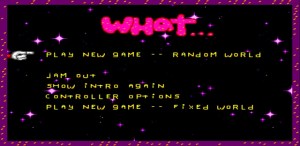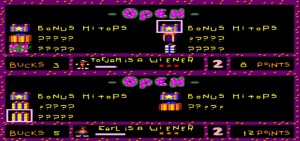My brother comes home from Japan (the Land of Videogames) after working there a year, and what's the first thing he wants to do? Play Toejam & Earl with me. So we play Toejam & Earl, and we still love it. And for good reason: its funk soundtrack is, in this writer's humble opinion, the greatest to ever be committed to cartridge. Its cartoon stylings capture perfectly the dissonance between our duo of chillaxed aliens stranded on a frenetic, hostile Planet Earth. It was both an hilarious parody of hip hop culture and a devilishly clever satire on modern Earth life. In an age when local multiplayer is treated as indulgence, and cooperative play a fiscal liability, Toejam & Earl represents one of the most delightful experiences that can be shared with two controllers. All of these things comprise the funny, funky package that is Toejam & Earl, but they are not reason enough for its remarkable longevity. There are many other titles that could be said to be "the full package" and yet I can almost guarantee I won't be playing them in 18 years time. Those who have played Toejam & Earl will find all this talk of packages to be rather apt. The game is every bit as surprising as the wrapped gifts that feature so prominently in it. If I could summarise the essence and appeal of Toejam & Earl in a single word, that word would be 'Random'. No two play-throughs of Toejam & Earl are ever the same, lending the game virtually limitless replay value. Let's explore this Funkotronian phenomenon to see how it achieves this rare feat.
1. Random World The game begins with a choice of either 'Play New Game -- Fixed World', 'Jam Out', or 'Play New Game -- Random World'. Now, the Fixed World features set levels that will always be the same geographically, with set locations for ship pieces [your goal is to reconstruct your broken rocketship, the parts of which are scattered throughout the game] and elevators [the end of each level]. Just about everything that populates them remains random, but it's good if you're strapped for time and you need a ball-park game length. Random World is a huge part of the game's appeal. This is the mode that seasoned players return to time and time again, because the experience is always different. It's always different anyway, for reasons I will go into later, but the geography is never the same. Sure, it follows guidelines - for instance, Mailbox Monsters are not introduced until Level 4, quicksand will only enter the game's repertoire by Level 6, and Level 13 is invariably a warzone packed with tomato-firing chickens with mortars - but it's not a random selection of pre-drawn levels; each level is randomly generated; each Earthling, item, and elevator randomly placed; and each ship piece randomly scattered throughout the game. This is why it is often referred to as a 'Roguelike' - a reference to the dungeon-crawler Rogue which popularised the use of randomly-generated levels and items - despite its distinct lack of dungeons or crawling. But you'll soon see how Toejam & Earl takes this formula even further. Anyway, with circumnavigation playing such a major role in the game, it's easy to see how much an ever-changing landscape can add to its replay value. 'Jam Out' has got to be one of the world's first music rhythm games. It essentially showcases the game's excellent jazz-funk/hip hop soundtrack, allowing you to play beats or in-game sound effects over the top with both controllers. This mode comes in both 'Fixed' and 'Random' flavours also, assigning either preset beats to each button in the former, or allowing the player to switch between randomly-assigned sound effects from the game in the latter, often to hilarious results.
2. Presents For all its apparent hellishness, planet Earth seemingly has a lot to give as well. There are myriad presents scattered about each level, and these gift-wrapped wonders are the cornerstone of the game's evergreen appeal. Each present is a veritable Pandora's Box, with the curiosity/caution-inspiring '????????' beside each one in your inventory. That is, until you open one, and all other presents that share its appearance are now known to contain that particular item. A small, red box with a yellow bow could be a pair of spring shoes in one game, or rocket skates in another. A large, pink box with white polka dots could be five bucks, or it could just as well be a nasty bout of tomato rain. As long as they remain unopened, they have the equal capacity to be something awesome, something utterly life-threatening, or something downright useless in certain situations. Some presents remain random even when their contents are known. 'Food' could be something tasty that increases your life-bar, or something awful that diminishes it. With two players together, the 'food' present can be beneficial to one while harmful to the other, and so forth. The 'Earthling' present could yield a helpful Viking lady or a swarm of killer bees. The 'doorway' present reveals a mystery door that when walked through, transports the player to a random place on the map. If both players are present, that same doorway will lead to two completely different locations. Presents with question mark ['?'] wrapping are other presents in disguise; random within random. This process of discovery can be immensely satisfying, but each present opened brings you one step closer to accidentally opening the dreaded 'Randomizer', which re-shuffles the appearance and contents of every single present in your possession, and in the game. Of course, you could be lumbered with a swag of undesirable items, in which case another spin of the roulette wheel may not be such a bad thing. It's just one of the many ways that TJ&E continually changes itself up, even mid-game.


